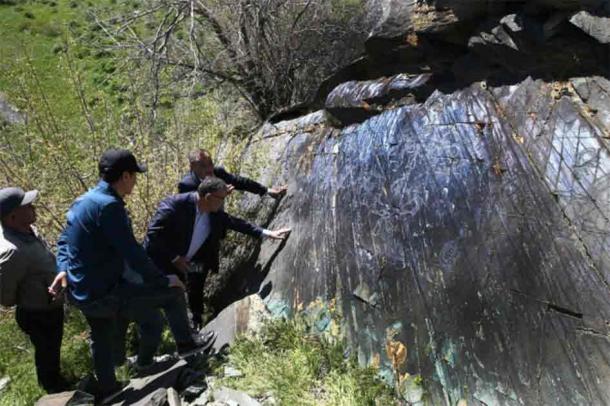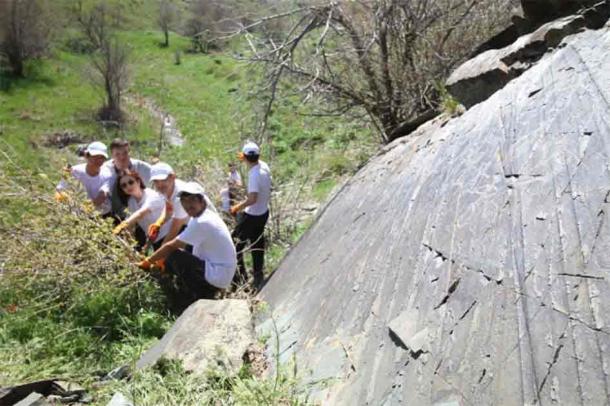4,000-Year-Old Petroglyphs Discovered on Rock Outcropping in Kazakhstan
While laboring in southern Kazakhstan in the Karatau Mountains as part of a crew involved in an environmental restoration campaign, a group of volunteers were shocked but delighted to discover a set of previously undetected rock carvings that likely date back to the Bronze Age (2,000 BC). There were dozens of images spanning the length of a long rock wall, all of which were still in good shape despite their obvious antiquity.
“We stumbled upon very unusual drawings, and to understand their significance, we sought the expertise of archaeologists,” volunteer spokesperson Assylzhan Pazylbekov said in a statement published by Kazakhstan’s Astana Times. “We hope this discovery will shed new light on history.”
Rock carvings have been found in different parts of Kazakhstan, so the country’s archaeologists are quite familiar with them and have established some solid timelines for their creation. Based on the style and contents of the newly discovered images, the experts estimate that they may be as much as 4,000 years old. This is only a tentative estimate, however, and more research will be required to pin down the age of this impressive petroglyph collection more precisely.
- Petroglyphs Park Woodview in Ontario, Canada Has Over 1,000 Petroglyphs
- “15,000-year-old” Gobi Desert Petroglyphs Made By Ancient Turks?

Newly discovered petroglyphs dating back to the Bronze Age. (Department of Internal Policy of the Akimat of the Zhambyl Region)
The Petroglyph Makers of Bronze Age Kazakhstan Truly Left their Mark
Under the auspices of the nationwide Taza (Clean) Kazakhstan environmental initiative, the volunteers were working on a landscaping project in the country’s mountainous Zhambyl region when they spotted the anomalous carvings.
Decorating the smooth face of a rock outcropping a little over two miles (3.5 kilometers) outside the village of Aktogay in the Sarysu district, these surprisingly well-preserved petroglyphs display a range of scenes from the daily lives of people who lived in the region thousands of years ago. The carvings include rich and vivid re-creations of people and animals, often in the context of hunting scenes. Some of the images are believed to have symbolic meaning, reflecting the shared beliefs and worldviews of the Bronze Age peoples who settled in this remote area in central Asia.
There are more than 100 images included in the newly discovered petroglyph mural, which extends to a height of more than six feet (two meters) above the ground and measures between 65 and 80 feet (20 and 25 meters) in length. The carvings are clear enough that it is possible to identify some of the animals they portray, which include sheep and double-humped camels.
Sauren Kaliyev, an archaeologist and historian who has been studying the petroglyphs, emphasized how unusual it was to find so many carvings covering a single, unbroken surface in Zhambyl. But ancient petroglyphs are common in the area overall.
“The Karatau mountain range holds great historical and geographical significance. It is one of the unique sites of human civilization not only in the history of Kazakhstan but also in world history,” Kaliyev stated, acknowledging the greater context of the new find.
- Dinosaur Tracks in Brazil Found to Have Petroglyph Companions
- Are Toro Muerto's Petroglyphs in Peru Hallucinogenic Visions in Stone?

Group of researchers at the petroglyph site. (Photo credit: Department of Internal Policy of the Akimat of the Zhambyl Region)
Petroglyphs of Karatau Mountains
The very first petroglyphs ever found in southern Kazakhstan’s Karatau Mountains were spotted by a photographer named M.N. Kirchhoff, who discovered them covering various rocky surfaces in Besaryk Gorge in 1906. For the most part the ancient rock carvers were opportunistic, choosing to leave their works of art on rocks and boulders of various sizes and shapes that were smooth enough to be used as a “canvas.”
While many of the petroglyphs in the area date to the second millennium BC, others were made more recently. In fact, some of the carvings are believed to have been made as late as the Middle Ages.
Taken as a whole, the rock carvings found in the Karatau Mountains represent a broad spectrum of imagery, which portrays not just hunting scenes or other domestic activities but shapes and images that reveal important details about the customs, rituals and spiritual beliefs of the nomadic groups to which the rock artists belonged. Much of this will likely be reflected in the content of the newly identified carvings, which are still being analyzed and interpreted.
Protecting Precious Ancient Sites is a Priority in Kazakhstan
Government authorities in Kazakhstan plan to preserve the newly discovered petroglyph site for posterity.
“We will continue our research and conduct a state examination, as we intend to designate it a site of national or international significance to be included in the list of state-protected sites,” declared Kuanysh Daurenbekov, director of Kazakhstan’s Directorate for the Protection and Restoration of Historical and Cultural Monuments.
There are already 3,468 historical and cultural monuments that have been given protected status in the Zhambyl region. It seems virtually certain that the newly discovered site will be added to Kazakhstan’s list of protected monuments very quickly, meaning archaeologists will have plenty of opportunity to study the site’s amazing collection of petroglyphs in the months and years ahead.
Top image: Archeologists and historians examining petroglyphs in the Zhambyl Region. Source: Department of Internal Policy of the Akimat of the Zhambyl Region
By Nathan Falde
















